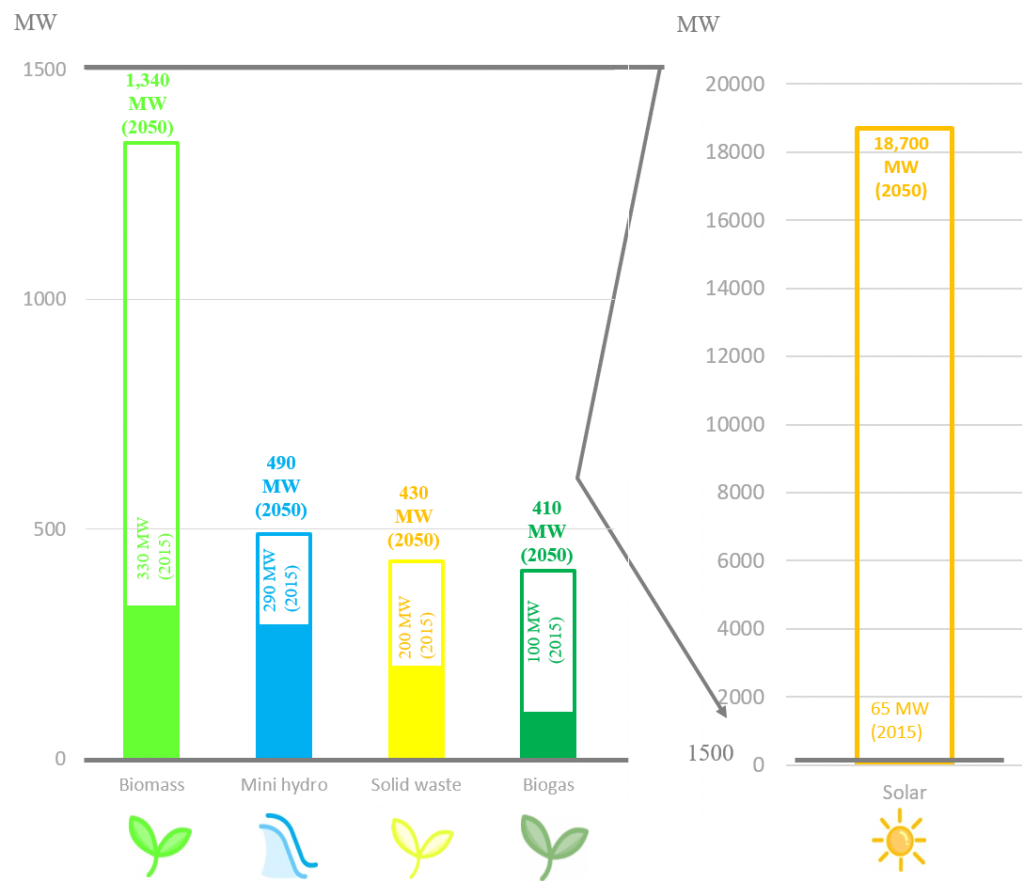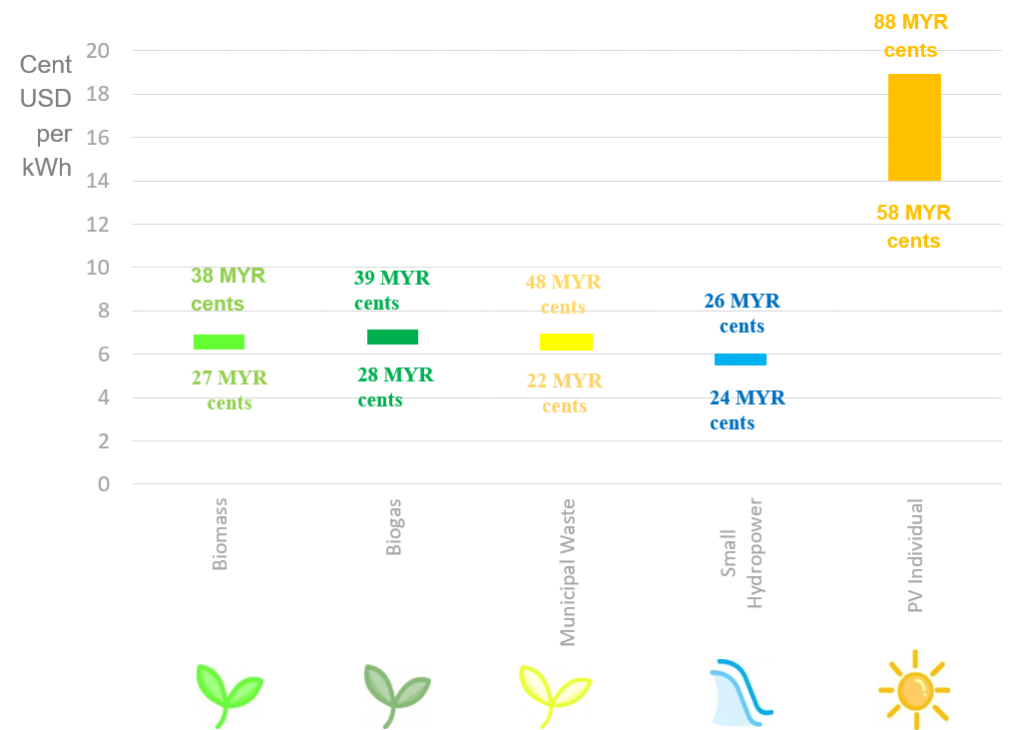The National Renewable Energy Policy and Action Plan (NREPAP) is the most recent development of energy policy that focuses directly on the renewable energy sector. It defines five strategic thrusts for development of renewable energy: increase RE contribution in the national power generation mix, facilitate the growth of the RE industry, ensure reasonable RE generation costs, conserve the environment for future generations, and enhance awareness on the role and importance of RE. In 2018 MESTECC has set a new RE Target for Malaysia to achieve 20% RE capacity in 2025 as reported in MESTECC Initiatives 2019
Mal Malaysia’s renewable energy targets are outlined in the NREPAP which is a long-term plan for renewable energy development (Figure 4). Mini-hydropower is expected to reach its maximum capacity by 2020. The biomass and biogas are predicted to grow until their peaks are reached in 2028. Until then, biomass will be the renewable energy source with the highest installed capacity. The overall mix of installed capacity will significantly change afterward, as solar is expected to grow constantly beyond 2025, while other sources will have reached their limit by then. By 2050, solar energy is likely to cover the biggest share of installed capacity of RE.
Malaysia’s Renewable Energy Targets (until 2050)

Source: RE-SSN (2016)
The total RE installed capacity in Malaysia is 586.98 MW in 2018 (as of December). Biomass (include solid waste 12.85 MW installed capacity) has the second highest installed capacity, amounting to around 93.75 MW (Figure 5). There are very high demands from the private sector to develop solar PV projects, hence the share of solar PV accounts to 65%. Only small hydropower (SHP) with installed capacity of up to 18 MW is considered as RE source in Malaysia. At the moment, the shared of SHP in installed capacity is only 9%. Future development of SHP will be limited to some extent as potential sites in the Peninsular Malaysia have been almost completely exploited.
Malaysia's RE Installed Capacity in 2018 (%)
Source: SEDA website [Accessed December 2018]
The total power generation from RE sources in Malaysia is 878,348 MWh in 2018. Solar is the dominant sources for energy generation from renewable energy sources with the share of around 45%. Biomass also plays an important role with the share of 24% that includes the electricity generated from solid waste of around 4,102 MWh or 0.5% from the total power generation in 2018. (Figure 6).
Malaysia's Renewable Energy Electricity Generation in 2018 (%)
Source: SEDA website [Accessed December 2018]
The Government of Malaysia has introduced several mechanisms to encourage renewable energy development. There is a possibility to obtain grants or soft loans for renewable energy project. Other incentives are also offered such as tax exemptions, development of renewable energy pricing system, determination of interconnection procedure and metering policy, etc.
The renewable energy sector in Malaysia is regulated by the government through the introduction of Feed-in Tariff (FiT) license, technical requirements for grid connection, and FiT quotas. The FiT scheme in Malaysia covers biomass, biogas, small hydro, and solar photovoltaic (Figure 7). The rates depend on type of technology, installed capacity, and commencement date. Additional bonus FiT can be obtained in case the installed system meets special SEDA’s criteria. For example, a project which uses domestic manufactured or assembled solar photovoltaic modules can get a bonus.
The renewable energy power plant that start its operation later will be subject to a lower FiT because mostly the cost of investment and production is lower than previous years. Therefore, The FiT in Malaysia is applying the regression rate in order to encourage technological cost reductions. However, after commercial operation date (COD), the FiT will not decrease anymore until it is reviewed by the authority every three years.
In October 2018, The Sustainable Energy Development Authority (SEDA) Malaysia has revoked non-performing Feed-in Tariff (FiT) projects in total of 155.7256 MW and will release a total quota of 114.5682 MW. The quota for small hydro category will be set to 5,682 MW expected to achieve commercial operations by 2020 and 2021. The quota allocated for biogas is 30 MW whereas for biomass is 10 MW for 2021.
In addition to the current FiT mechanism, a new instrument termed as Net Energy Metering (NEM) has been implemented. The objective of NEM is to promote and encourage more renewable energy generation, by prioritizing internal consumption before any excess electricity generated is fed to the grid. The introduction of NEM is to achieve the stipulated non-large-hydro renewable energy targets. Unlike FiT, only excess electricity generated from the solar PV system will be sold to the grid. As a result, it will incentivize efficient electricity consumption since the return on investment for the facility is associated with electricity savings (amount of electricity sold to the grid). Under the NEM, the capacity limits for residential are 12 kW (single phase) and 72 kW (three phase), and 1 MW for non-residential (subject to terms and conditions). NEM will be applicable to solar PV rooftop installations power generation to achieve a cumulative solar capacity of 500 MW by 2020.
The Renewable Act outlines the terms of acquiring a distribution license needed to generate renewable energy in Malaysia, namely the Renewable Energy (Administrative Fees) Rules 2011 and Renewable Energy (Recovery of Moneys by Distribution License) Rules 2014.
MESTECC introduced a new scheme under a widened supply agreement for renewable energy (SARE) programme. With this concept, users will have zero upfront cost to install photovoltaic (PV) panels, and payment for the monthly leasing fee or solar energy usage can be made to the solar company involved via TNB bills, The users will immediately start earning benefits in the form of lower electricity bills. Essentially, the solar leasing company is selling you power at a reduced rate, generated from the newly installed solar panels. Savings vary from 5%- 25% on monthly electricity bills.
FiT in Malaysia as per 28 January 2019
 Source: SEDA portal [Accessed January 2019]
Source: SEDA portal [Accessed January 2019]
Note: The conversion rate from Malaysian Ringgit (MYR) to US Dollar (USD) is 0.24 (as of January 2019).